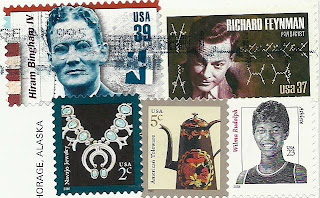 Mt. McKinley, Alaska
Mt. McKinley, Alaska
Rising 20,320 feet (6,194 m) from sea level, Mt. McKinley has a greater mystical rise the Mt. Everest.
Sent by
The Lowe Family, postcrosser from Washington, USA.
This is from Wikipedia :
Mount McKinley or
Denali (Koyukon Athabaskan for "The High One", Dghelaayce’e in Ahtna) in Alaska, United States is the highest mountain peak in North America and the United States, with a summit elevation of 20,320 feet (6,194 m) above sea level. The CIA World Factbook lists its summit elevation as 6,198 metres (20,335 ft). It is the centerpiece of Denali National Park and Preserve.
Mount McKinley is a granitic pluton. It has been uplifted by tectonic pressure while at the same time, erosion has stripped away the (somewhat softer) sedimentary rock above and around the mountain.
The forces that lifted Mount McKinley—the subduction of the Pacific plate beneath the North American plate—also raised great ranges across southern Alaska. As that huge sheet of ocean-floor rock plunges downward into the mantle, it shoves and crumples the continent into soaring mountains which include some of the most active volcanoes on the continent. Mount McKinley in particular is uplifted relative to the rocks around it because it is at the intersection of major active strike-slip faults (faults that move rocks laterally across the Earth's surface) which allow the deep buried rocks to be unroofed more rapidly compared to those around them.
Mount McKinley has two significant summits: the South Summit is the higher one, while the North Summit has an elevation of 19,470 feet (5,934 m) and a prominence of approximately 1,320 feet (402 m). The North Summit is sometimes counted as a separate peak (see e.g., the List of United States fourteeners) and sometimes not; it is rarely climbed, except by those doing routes on the north side of the massif.
Five large glaciers flow off the slopes of the mountain. The Peters Glacier lies on the northwest side of the massif, while the Muldrow Glacier falls from its northeast slopes. Just to the east of the Muldrow, and abutting the eastern side of the massif, is the Traleika Glacier. The Ruth Glacier lies to the southeast of the mountain, and the Kahiltna Glacier leads up to the southwest side of the mountain.
The Koyukon Athabaskan people who inhabit the area around the mountain referred to the peak as Dinale or Denali ("the high one" or "the great one"). In the late 1890s, a gold prospector named it "McKinley" as political support for then-president William McKinley. The Alaska Board of Geographic Names changed the name of the mountain to Denali, which is how it is referred to locally. However, a 1975 request by the Alaska state legislature to the United States Board on Geographic Names to do the same was blocked by Ohio congressman Ralph Regula, whose district includes McKinley's hometown. Members of the Ohio congressional delegation continue to protect the McKinley name, blocking attempts by the Alaska congressional delegation to get the Board of Geographic Names to change it to Denali. Thus, "Denali" is correct according to the Alaska state board, while "McKinley" is correct according to the national board.
































